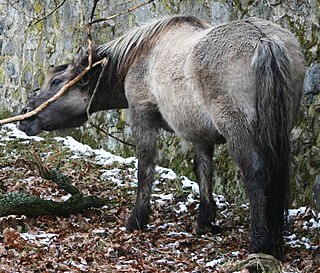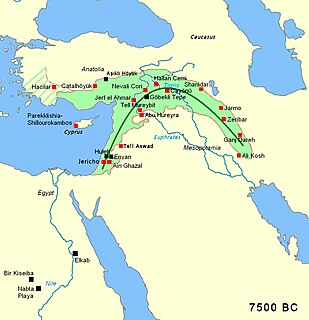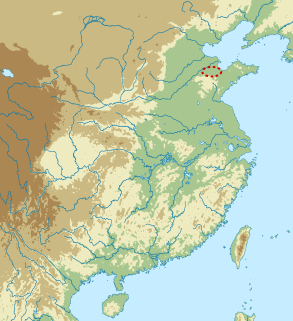Mali is located in Africa. The history of the territory of modern Mali may be divided into:

Millets are a group of highly variable small-seeded grasses, widely grown around the world as cereal crops or grains for fodder and human food.

Panicum miliaceum is a grain crop with many common names including proso millet, broomcorn millet, common millet, hog millet, Kashfi millet, red millet, and white millet. Archeological evidence suggests that the crop was first domesticated before 10,000 BCE in Northern China. The crop is extensively cultivated in China, India, Nepal, Russia, Ukraine, Belarus, the Middle East, Turkey, Romania, and the United States, where about half a million acres are grown each year. The crop is notable both for its extremely short lifespan, with some varieties producing grain only 60 days after planting, and its low water requirements, producing grain more efficiently per unit of moisture than any other grain species tested. The name "proso millet" comes from the pan-Slavic general and generic name for millet. Proso millet is a relative of foxtail millet, pearl millet, maize, and sorghum within the grass subfamily Panicoideae. While all of these crops use C4 photosynthesis, the others all employ the NADP-ME as their primary carbon shuttle pathway, while the primary C4 carbon shuttle in proso millet is the NAD-ME pathway.

A number of hypotheses exist on many of the key issues regarding the domestication of the horse. Although horses appeared in Paleolithic cave art as early as 30,000 BCE, these were wild horses and were probably hunted for meat.

The Neolithic Revolution, or the (First) Agricultural Revolution, was the wide-scale transition of many human cultures during the Neolithic period from a lifestyle of hunting and gathering to one of agriculture and settlement, making an increasingly large population possible. These settled communities permitted humans to observe and experiment with plants to learn how they grew and developed. This new knowledge led to the domestication of plants.

Pearl millet is the most widely grown type of millet. It has been grown in Africa and the Indian subcontinent since prehistoric times. The center of diversity, and suggested area of domestication, for the crop is in the Sahel zone of West Africa. Recent archaeobotanical research has confirmed the presence of domesticated pearl millet on the Sahel zone of northern Mali between 2500 and 2000 BC. Cultivation subsequently spread and moved overseas to India. The earliest archaeological records in the Indian subcontinent date to around 2000 BC, and it spread rapidly through Northern Indian subcontinent reaching South India by 1500 BC, based on evidence from the site of Hallur. Cultivation also spread throughout eastern and southern parts of Africa. Pearl millet is widely grown in the northeastern part of Nigeria. It is a major source of food to the local villagers of that region. The crop grows easily in that region due to its ability to withstand harsh weather conditions like drought and flood. Records exist for cultivation of pearl millet in the United States in the 1850s, and the crop was introduced into Brazil in the 1960s.

The history of West Africa has been commonly divided into its prehistory, the Iron Age in Africa, the major polities flourishing, the colonial period, and finally the post-independence era, in which the current nations were formed. West Africa is west of an imagined north-south axis lying close to 10° east longitude, bordered by the Atlantic Ocean and Sahara Desert.

The Painted Grey Ware culture (PGW) is an Iron Age Indian culture of the western Gangetic plain and the Ghaggar-Hakra valley in the Indian subcontinent, conventionally dated c.1200 to 600–500 BCE, though newer publications have suggested a range of 1500 to 700 BCE, or from 1300 to 500–300 BC It is a successor of the Cemetery H culture and Black and red ware culture (BRW) within this region, and contemporary with the continuation of the BRW culture in the eastern Gangetic plain and Central India.

Piki Mach'ay is an archaeological site in the Ayacucho Valley of Peru. Radiocarbon dates from this cave give a human presence ranging from 22,200 to 14,700 years ago, but this evidence has been disputed and a more conservative date 12,000 years BCE seems possible.

In the prehistory of the Indian subcontinent, an "Iron Age" is recognized as succeeding the Late Harappan culture. The main Iron Age archaeological cultures of present-day northern India are the Painted Grey Ware culture and the Northern Black Polished Ware. This corresponds to the transition of the Janapadas or principalities of the Vedic period to the sixteen Mahajanapadas or region-states of the early historic period, culminating in the emergence of the Maurya Empire towards the end of the period.

The Houli culture was a Neolithic culture in Shandong, China. The people of the culture lived in square, semi-subterranean houses. The most commonly found artefacts at Houli sites are pottery and stone tools. Jade artefacts and bone, antler, shell tools were also found at Houli sites. While the remains of domesticated dogs and pigs in the early stages of domestication were found at some sites associated with the culture, the people of the Houli culture relied mostly on hunting and fishing. The remains of rice, broomcorn millet, and foxtail millet were discovered at Houli sites.

Djenné-Djenno is a UNESCO World Heritage Site located in the Niger River Valley in the country of Mali. Literally translated to "ancient Djenné", it is the original site of both Djenné and Mali and is considered to be among the oldest urbanized centers and the best-known archaeology site in sub-Saharan Africa. This archaeological site is located about 3 kilometres (1.9 mi) away from the modern town, and is believed to have been involved in long distance trade and possibly the domestication of African rice. The site is believed to exceed 33 hectares ; however this is yet to be confirmed with extensive survey work. With the help of archaeological excavations mainly by Susan and Roderick McIntosh, the site is known to have been occupied from 250 B.C. to 900 A.D. The city is believed to have been abandoned and moved where the current city is located due to the spread of Islam and the building of the Great Mosque of Djenné. Previously, it was assumed that advanced trade networks and complex societies did not exist in the region until the arrival of traders from Southwest Asia. However, sites such as Djenné-Djenno disprove this, as these traditions in West Africa flourished long before.

Hallur is an archaeological site located in the Haveri district, in the Indian state of Karnataka. Hallur, South India's earliest Iron Age site, lies in a semi-arid region with scrub vegetation, located on the banks of the river Tungabhadra. The site is a low mound about 6.4 m high. The site was first discovered by Nagaraja Rao in 1962, and excavated in 1965. Further sampling was carried out in the late 1990s for the recovery of archaeobotanical evidence and new high precision radiocarbon dates

The Kansas City Hopewell were the farthest west regional variation of the Hopewell tradition of the Middle Woodland period. Sites were located in Kansas and Missouri around the mouth of the Kansas River where it enters the Missouri River. There are 30 recorded Kansas City Hopewell sites.
South and West Asia consists of a wide region extending from the present-day country of Turkey in the west to Bangladesh and India in the east.

Iraq ed-Dubb, or the Cave of the Bear, is an early Neolithic archeological site 7 km (4.3 mi) northwest of Ajlun in the Jordan Valley, in modern-day Jordan. The settlement existed before 8,000 BCE and experimented with the cultivation of founder crops, side by side with the harvesting of wild cereals. Along with Tell Aswad in Syria, the site shows the earliest reference to domestic hulled barley between 10,000 and 8,800 BCE. The site is located on a forested limestone escarpment above the Wadi el-Yabis in northwest Jordan. An oval-shaped stone structure was excavated along with two burials and a variety of animal and plant remains.
Coxcatlan Cave is a Mesoamerican archaeological site in the Tehuacán Valley of Puebla, Mexico. It was discovered by Richard MacNeish in the 1960s during a survey of the Tehuacán Valley. It was the initial appearance of three domesticated plants in the Tehuacan Valley and allowed an evaluation to be done again of the overall temporal context of the plant domestication in Mexico. In addition to plants, Coxcatlan Cave also provided nearly 75 percent of the classified stone tools from excavation.
Xinglonggou is a Neolithic through Bronze Age archaeological site complex consisting of three separate sites. The sites are located on a loess slope above the left bank of the Mangniu River north of the Qilaotu Mountains in Aohan Banner, Inner Mongolia, China. Xinglonggou is one of the most important sites of the early Neolithic Xinglongwa culture and provides evidence for the development of millet cultivation. The millet assemblage at Xinglonggou consists primarily of broomcorn millet. Xinglonggou is one of the few, early Neolithic sites in China for which systematic flotation has been performed.












